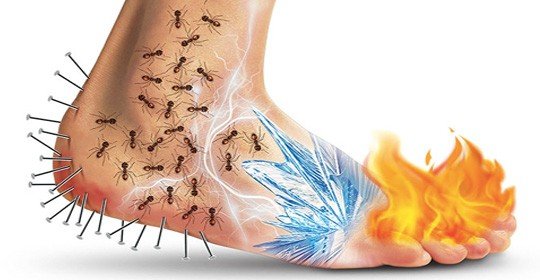
Unlike tissue pain, neuropathic pain is pain caused by damage or disease in any part of the nervous system. Therefore, a false alarm sounds, a razor does not cut you, but you feel a pain as if you are cutting. Or they say it looks like it’s on fire, for example, diabetics say that the bottoms of their feet are burning. Although neuropathic pain cuts people off from life, it is a pain that can be cured if treated correctly.
In normal pain, that is, in tissue pain, a healthy nervous system informs us of the feeling of pain because for the alarm to sound, the cable between the alarm and the system must be intact. For example, if your hand is cut off with a razor, the nerves announce the feeling of being cut with a razor blade to our brain.
Allodynia is the feeling of cutting a razor blade when one’s body is touched, even with a soft object such as cotton, and reacting like a false alarm.
Phantom pain (phantom pain) is the feeling of pain, assuming that a cut organ is in place.
The reason why we don’t know the frequency of neuropathic pain is if we look at neuropathic pain in some diseases such as diabetes, the frequency is around 1-2 percent, but this may go up to 10 percent because many things can turn into neuropathic pain. For example, when nerve compression, lumbar hernia pain progresses and becomes chronic when it causes nerve damage, these also cause neuropathic pain. It’s hard to empathize, but there are those who feel both burn and freeze because both are false alarms, such pains are neuropathic pains and these are chronic pains. These pains are pains that take people away from life.
Since every part of our body is covered with nerves, neuropathic pain can occur anywhere in our body. For example, diabetic patients mostly experience pain in the feet and hands. The patient’s foot burns, numbs, tingles and says that as the disease progresses, the pain spreads to the hands. Unlike tissue pain, neuropathic pain occurs and increases at night. On top of that, it can occur not only in pain, but also in insomnia and other related problems. Although it is seen in both Type-1 and Type-2 diabetes, neuropathy is a little more common in type-2 patients. The reason is that the duration of sugar in diabetes and the high level of sugar, which we call glycemia level, are risk factors for the development of neuropathy. Someone who has had diabetes for 10-15 years has a higher risk than someone who has had diabetes for 2-3 years. In type 1 diabetes, if insulin is used, the sugar level is well controlled, and if you control sugar, the development of neuropathy is lower.
Tingling is also a neuropathic pain, for example, when you cross your legs, you feel tingling after a while and you lower your leg, but neuropathic pain patients experience it all the time. Itching can also be a symptom of neuropathic pain, it can be a maddening itch. If it’s not a tissue problem but a false alarm of the nerve, you can’t silence it. In order to prevent pain, it is necessary to correctly name the disease and apply the right treatment.
The people who know neuropathy very well are patients. Tingling is a good complaint for neuropathic pain. It is tingling, tingling, numbness but it is an uncomfortable numbness, burning may occur. The frostbite may feel like a razor cut or ingrown nail, which may feel like direct pain. It may feel a sting like an electric shock, not tissue damage. Unless you’re really getting electrocuted, it’s a nerve pain, but there may be rare symptoms such as itching. There is a very important symptom, which we call allodynia, the feeling of pain when touched. Normally, when you touch a person with a cotton ball, they do not feel pain, but in neuropathic pain, the lines in the nerves are so confused; the anger transmits what it receives to the wrong place. The brain thinks cotton is a razor, it feels a pain in the brain as if it were cut with a razor. This is very typical in neuropathic pain.
It is very important to name the problem correctly in treatment. Our first question to the patient is, “Is the pain reliever good?” When the patient says “it feels very good”, there is something wrong there. Painkillers are not good for neuropathic pain, but if there is a tissue problem with it, it can be a little good if it also contributes to the pain. There are drugs that only relieve neuropathic pain, and they are drugs that have no effect on any other pain. These drugs are extremely successful when used correctly and properly.
However, when we say let’s treat the neuropathy that causes these pains, we do some tests for the etiology. enough for

